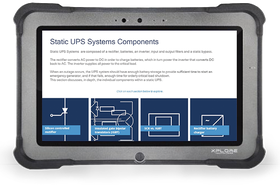When we design the energy protection system for data center infrastructure, it is necessary to consider many parameters, such as the topology of the UPS, stand-alone or modular, transformer-based or transformer-free, parallel and/or redundant configurations, energy efficiency, capital expenditure and operational expenditure costs, and many other parameters.
The evaluation process before buying the perfect power protection system is often focused on efficiency, flexibility, and resilience – fundamental characteristics the UPS must embody in order to meet the stringent construction requirements of a data center, whether small, medium, or large.
But the dynamics related to the manufacturer's after-sales services are additional drivers that have to be considered when selecting the UPS.
It is a matter of fact that the primary reason for installing the UPS is that it provides ‘clean’ power without interruptions. Yet having a UPS means recognizing the vital importance of maintaining the power protection systems in perfect operational condition. It is therefore essential to consider the overall cost of any UPS failure, however unlikely it may be.
For this purpose, it is necessary to take into account not only the cost of a possible repair of the equipment, but also the costs related to downtime, during which the critical application will not be protected, and perhaps not even powered: in these circumstances the goal of the maintenance is to reduce this risk as much as possible.
In most cases, recommending the completion of maintenance contracts as the optimal solution to keep an installation in perfect working order, the manufacturers also must offer a complete range of high-quality services, including:
Experience: all the advantages for assistance and logistics deriving from being a designer, manufacturer, and maintenance technician;
Traceability: full traceability of the UPS, right from its construction;
Availability: continuous availability of spare parts of guaranteed origin for all UPS in service;
Know-how: guarantee of on-site interventions carried out by the manufacturer's technicians;
Speed: commitment to optimize repair times;
Performance: certainty of taking advantage of the latest solutions and technologies made available by the manufacturer;
Environmental protection: UPS manufacturers are committed to respecting the highest standards in environmental protection and persevere in scrupulous compliance with all directives and certifications.
If we consider the manufacturer is efficient in providing all the services described above in a timely manner, the risk of downtime remains minimized: but what if this does not happen or just one of those vital conditions fails? What are the alternatives that a data center manager or any other end-customer can further request or gain by the manufacturer?
In this case, the manufacturer's flexibility to provide a large level of autonomy for maintenance operations carried out directly by the customer is the winning key.
Having free direct access to the firmware, to the management software and the monitoring system of the UPSs represents a considerable advantage in the event of anomalies or unexpected failures. In addition, the full availability of all the manufacturer's professional service software grants immediate diagnostic intervention, even in cases where the service technicians are unable to intervene quickly.
Furthermore, another facilitating factor that the manufacturer can provide to the customer is the robustness of the software management on board the UPS: solid and stable software, not subject to excessively frequent revisions, and thoroughly tested before distribution, takes up the philosophy of the most robust operating system distributions, and is indisputably an advantage for those who have to perform maintenance interventions or system updates.
With the UPS manufacturer the partner for the entire useful cycle of the power system, the services are not evaluated on the basis of an initial cost, but on the overall cost that must take into account the advantages of maintenance carried out by the manufacturer, giving flexibility, autonomy and the possibility of intervention to the customer as well.
With this new concept of maximum maintenance flexibility and attention to customer needs, the manufacturer can avoid costly downtime, and can offer spare parts and assistance without applying cumulative margins.




